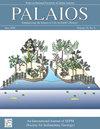ZECHSTEIN群(洛平阶)真菌孢粉形态的首次报告:对地球古生代真菌记录地层完整性的启示
IF 1.5
4区 地球科学
Q2 GEOLOGY
引用次数: 2
摘要
摘要:对二叠纪-三叠纪边界的孢粉学研究通常集中在花粉粒和孢子含量上,以重建植被,真菌遗骸要么未经鉴定,要么留待未来研究。古生代真菌微体化石记录尤其缺乏。泽克斯坦群(~258–252 Ma;洛平阶)是一个由碳酸盐岩和蒸发岩堆叠而成的引人注目的地层序列。对英格兰东北部泽克斯坦群新钻孔岩芯的高分辨率孢粉学分析揭示了其整个沉积学历史,并使欧洲中西部二叠纪-三叠纪边界之前的植被动力学能够得到新的重建。在整个序列中,由针叶树、蕨类植物、蕨类植物和苏铁/银杏组成的组合与真菌遗骸一起被发现。观察到四种真菌形态,最常见的是内生Chytridiomycota或Hypochytridioomcota亲和性的光滑壁球形内含物。真菌的其他证据包括附生Callimothallus型真菌(小聚伞科)、与土壤、纤维素和植物碎屑有关的暗色似毛霉菌(毛霉菌科),以及植物角质层表面由壶菌引起的点蚀的可能证据。这是第一项强调Zechstein孢粉制剂中真菌含量的研究,虽然这种情况很少发生,但它们为Zechstein森林下层的组成提供了新的见解,强化了Zechstein上部环境潮湿的解释。这项工作提高了我们对洛平期蒸发岩系统真菌分类群的分类和功能多样性的理解,并突出了岩盐的特殊保存潜力,克服了化石记录中对真菌丰富度的低估。本文章由计算机程序翻译,如有差异,请以英文原文为准。
FIRST REPORT OF FUNGAL PALYNOMORPHS FROM THE ZECHSTEIN GROUP (LOPINGIAN): IMPLICATIONS FOR THE STRATIGRAPHIC COMPLETENESS OF THE EARTH'S PALEOZOIC FUNGAL RECORD
Abstract: Palynological study of the Permian–Triassic boundary has typically focused on the pollen grain and spore content to reconstruct vegetation, with fungal remains either left unidentified or set aside for future research. Paleozoic fungal microfossil records in particular are lacking. The Zechstein Group (∼ 258–252 Ma; Lopingian) is a remarkable stratigraphic sequence of stacked carbonates and evaporites. High-resolution palynological analysis of new borehole cores through the Zechstein Group of northeast England has revealed its entire sedimentological history and enabled a new reconstruction of vegetation dynamics in central-western Europe preceding the Permian–Triassic boundary. Assemblages composed of conifers, pteridosperms, pteridophytes, sphenopsids, and cycads/ginkgoes were recovered alongside fungal remains throughout the entire sequence. Four fungal morphologies were observed, the most common being smooth-walled spheroidal inclusions of an endobiotic Chytridiomycota or Hypochytridiomycota affinity. Other evidence of fungi includes epiphytic Callimothallus-type fungi (Family Microthyraceae), the dematiaceous Chaetomium-like mold (Family Chaetomiaceae) found associated with soil, cellulose and plant debris, and possible evidence of chytrid-induced pitting on the surface of plant cuticle. This is the first study to highlight the fungal content of Zechstein palynological preparations and while occurrences are rare, they provide new insight into the composition of the Zechstein forest understory, reinforcing the interpretation that the upper Zechstein environment was humid. This work improves our understanding of the taxonomic and functional diversity of fungal taxa associated with evaporite systems during the Lopingian, and highlights the exceptional preservation potential of halite, combating underestimates of fungal richness in the fossil record.
求助全文
通过发布文献求助,成功后即可免费获取论文全文。
去求助
来源期刊

Palaios
地学-地质学
CiteScore
2.80
自引率
12.50%
发文量
40
审稿时长
6 months
期刊介绍:
PALAIOS is a monthly journal, founded in 1986, dedicated to emphasizing the impact of life on Earth''s history as recorded in the paleontological and sedimentological records. PALAIOS disseminates information to an international spectrum of geologists and biologists interested in a broad range of topics, including, but not limited to, biogeochemistry, ichnology, paleoclimatology, paleoecology, paleoceanography, sedimentology, stratigraphy, geomicrobiology, paleobiogeochemistry, and astrobiology.
PALAIOS publishes original papers that emphasize using paleontology to answer important geological and biological questions that further our understanding of Earth history. Accordingly, manuscripts whose subject matter and conclusions have broader geologic implications are much more likely to be selected for publication. Given that the purpose of PALAIOS is to generate enthusiasm for paleontology among a broad spectrum of readers, the editors request the following: titles that generate immediate interest; abstracts that emphasize important conclusions; illustrations of professional caliber used in place of words; and lively, yet scholarly, text.
 求助内容:
求助内容: 应助结果提醒方式:
应助结果提醒方式:


